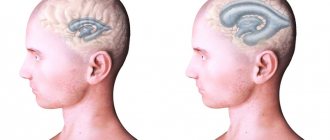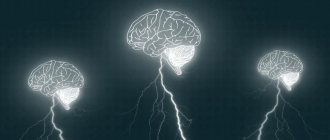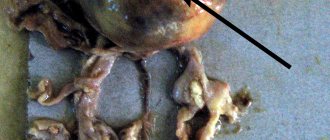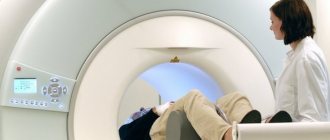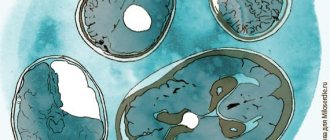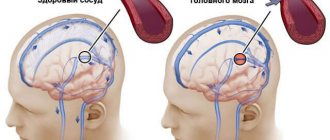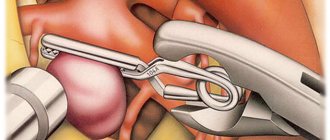© Author: A. Olesya Valerievna, candidate of medical sciences, practicing physician, teacher at a medical university, especially for SosudInfo.ru (about the authors)
The expansion of the subarachnoid space is often recorded based on the results of ultrasound of the brain in children or MRI in adults. This change may be subtle or clearly visible, as in the case of hydrocephalus. In all cases, such a phenomenon requires consultation with a neurologist, finding out the causes and deciding on treatment tactics.
Enlargement of the subarachnoid space is not an independent disease. It occurs in response to past injuries, abnormalities of embryonic development, and is characteristic of infections and tumors of the brain and its membranes. In fact, this is a reflection of many pathological processes inside the skull, so treatment varies in each specific case.
The conclusion about the expansion of the subarachnoid space is often encountered by parents of newborn babies who had an ultrasound scan in the maternity hospital and discovered abnormalities. As a rule, mothers and fathers do not know how to react, where to run and what to expect from pathology in the future. Answers to their questions should be given by pediatric neurologists, who observe such children especially carefully.
Expansion of the subarachnoid space on an MRI image
Symptoms of an enlarged subarachnoid space include a number of neurological manifestations, signs of hydrocephalus, intracranial hypertension, and possible focal symptoms in tumors. It is impossible to identify the main and strictly characteristic signs, as well as to make a diagnosis based on the clinical picture. Only additional instrumental examinations help shed light on the essence of the pathology.
To better understand what the subarachnoid space is and how it expands, you need to remember the main features of the structure of the brain and its membranes. So, everyone knows that the central organ of the nervous system is located in the cranium. Many people remember that on the outside it is covered with membranes that protect and nourish the nervous tissue.
The outermost is the dura mater of the brain, adjacent to the bones of the skull. It is extremely dense and provides mechanical protection against damage. On the surface of the brain lies a soft membrane, rich in blood vessels, and between it and the hard one is the arachnoid (arachnoid), which, due to their close relationship, are often combined into a single whole - the leptomeninges.
Under the arachnoid and above the pia mater there is a subarachnoid space in which cerebrospinal fluid circulates. Excess cerebrospinal fluid is absorbed by the arachnoid membrane, which contains connective tissue cells, fibroblasts, glial elements and forms special trabeculae (outgrowths) that reabsorb excess fluid.
Normally, the relationship between the soft and arachnoid (arachnoid) membranes is quite close, and the cerebrospinal fluid between them contains no more than 140 ml. The fluid circulating in the space between the membranes provides shock absorption to the brain, as well as nutrition, bringing useful things and taking away metabolic products from nerve cells.
With pathology, the distance between the membranes increases, there is more fluid, and on MRI there is a noticeable expansion of the corresponding intershell space, and the changes can be both local and diffuse in nature.
What types of external hydrocephalus of the brain are there?
External hydrocephalus of the brain refers to the accumulation of cerebrospinal fluid (cerebrospinal or cerebrospinal fluid) outside the cerebral hemispheres - in the subarachnoid space. Due to the large accumulation of fluid, the subarachnoid fissures widen, which causes increased pressure on the cerebral cortex and the resulting negative consequences.
The nature and level of complexity of the disease directly depend on the specific type of dropsy. Several criteria are used for classification. The most common ones are:
- intensity of manifestation (pronounced - accumulation of a large amount of cerebrospinal fluid, causing neurological symptoms; moderate - minimal amount of fluid, no signs);
- degree of impact on brain structures (compensated - cerebrospinal fluid does not affect the brain; decompensated - there is a deterioration in the functioning of the nervous system and brain);
- causes of occurrence (replacement - more often diagnosed in older people and is accompanied by the death of brain cells; acquired - occurs due to the spread of infections and mechanical traumatic brain injuries);
- nature of the course (chronic form - a gradual increase in neurological disorders; acute form - a sharp deterioration in the patient’s well-being).
Employees of the Department of Neurosurgery of the City Clinical Hospital named after. Eramishantsev will first determine the type of external hydrocephalus and only then begin treatment. Particular attention is paid to diagnostic data and a thorough study of the symptoms of the identified disease.
About the gap between the hemispheres
A gap between the hemispheres must be present, but its dimensions cannot exceed 3 mm. If it is slightly enlarged, then we can talk about the anatomical features of the child’s development.
The disease is indicated by a condition when the interhemispheric fissure is widened and filled with fluid. Often, the baby is diagnosed with diseases such as rickets, hydrocephalus or intracranial pressure. But doctors do not make a diagnosis based on neurosonography; the clinical picture is also important. This condition is also called dilatation. Sometimes the anomaly is detected immediately in the maternity hospital; it also happens that parents detect suspicious symptoms by the 5-6th month of the child’s life.
During the examination of the newborn, the doctor will ask the parents questions such as:
- What is the baby's sleep like, how many hours a day, what are the wakefulness intervals, etc.
- Regurgitation frequency.
- Is the child calm, does he have hysterics that last more than 5 minutes.
- Questions regarding the baby’s reflexes, how he reacts to changes in temperature, flashes of light, loud sounds.
- When a doctor examines a child for the presence of rickets, the disease may be indicated by an enlarged fontanel, a wide forehead and a smooth nape with worn-out hairs.
Neurosonography can reveal abnormalities in brain function, but the results of this study must be correctly deciphered.
The doctor also measures the circumference of the head, which makes it possible to suspect hydrocephalus, the color of the skin, the presence of a marbled pattern, checks the fontanel and eyes for the absence of strabismus or Graefe's syndrome (in which the child's eyes roll up so much that the whites are visible).
Symptoms of external hydrocephalus
The clinical picture in each specific case will be different, and the nature of the manifestation of the disease depends on the severity of the pathological process and the state of the central nervous system. Common symptoms are frequent headaches, blurred vision, nausea, vomiting, and weakness. By the way, pain is more localized in the frontoparietal region and in the area of the eyeballs. A person with dropsy experiences pain in the first half of the day, with sudden movements, coughing, sneezing, or severe physical exertion.
Symptoms may vary depending on the severity of the disease. Scientists distinguish 3 stages, and each has its own characteristics:
Mild external hydrocephalus. With a minimal amount of dropsy, the human body will try on its own to cope with such a problem as impaired circulation of the cerebrospinal fluid. In this case, you will feel a slight malaise, periodic dizziness, short-term darkening in the eyes, and a tolerable headache.
The middle stage of development of the disease. At this stage of the spread of the disease, symptoms appear intensely and are more pronounced. Due to an increase in intracranial pressure, severe headaches occur during physical activity, swelling of the optic nerve and facial tissues, increased fatigue, nervousness, depression, and surges in blood pressure.
Severe form of the disease. Signs of pathology in severe forms of external hydrocephalus are reduced to convulsive seizures, frequent fainting, a state of apathy, loss of intellectual abilities, memory loss and inability to care for oneself. Progressive dropsy can even lead to death, so there is no need to delay going to the doctor. It is better to do this at the first suspicion and a slight deterioration in health.
With chronic accumulation of cerebrospinal fluid, symptoms such as unsteady gait, paralysis of the upper and lower extremities, urinary incontinence, nighttime insomnia and daytime sleepiness, depressed mood, and a complex of psychoneurological disorders can be observed.
The main thing is the mode
It is worth noting that sleep problems in a newborn should be treated not through the use of medications, but only by normalizing the daily routine. It is necessary that the newborn be in the fresh air every day, and his room should always be ventilated; the nursery should be a little cool and fresh, and not hot and stuffy. You need to study how calm the environment is in your home: is there constant screaming, loud music, etc. After all, these factors can have a negative impact on the child’s psyche, so they should not exist.
Why does dropsy of the brain occur?
In adult patients, acquired hydrocephalus is often encountered, which develops either due to any mechanical damage to the head, or as a result of the development of pathological processes. Why does cerebrospinal fluid accumulate outside the cerebral hemispheres? The explanation is simple: brain structures are disrupted, adhesions appear in the veins, arachnoid villi are destroyed, and as a result, the cerebrospinal fluid does not circulate as it should.
If we delve deeper into the question of the causes of such a disease as external dropsy of the brain, we can identify some factors:
- infectious diseases (tuberculosis, meningitis, encephalitis);
- post-stroke condition, development of sepsis, extensive hemorrhage;
- concussion, head or cervical spine injury;
- malignant tumors that develop in the stem region.
Frequent intoxication of the body leads to the appearance of external hydrocephalus. For example, alcohol abuse, which damages neurons and leads to tissue death. Those patients who suffer from metabolic disorders, diabetes mellitus, multiple sclerosis, encephalopathy, and atherosclerosis are also at risk. Another reason that deserves due attention is irreversible age-related changes that cause aging of blood vessels and brain tissue.
Main services of Dr. Zavalishin’s clinic:
- consultation with a neurosurgeon
- treatment of spinal hernia
- brain surgery
- spine surgery
Stages of expansion of subarachnoid spaces
The location of the liquor-containing spaces determines the possibility of free flow from one tank to another. An increase in intracranial pressure is promoted by compression of blood vessels and ventricles of the brain by external formations, accumulation of blood (hematoma), edema, and inflammatory foci.
The main stages of expansion of the subarachnoid spaces:
- Moderate – exceeding the size by up to two millimeters;
- Average - up to four millimeters;
- Heavy – over 4 mm.
In an adult, the expansion of liquor-containing spaces is proportional to the growth of the head and swelling of the fontanelles. Detection of external changes requires timely treatment to prevent irreversible complications. Correct therapy allows you to restore dilated ventricles and liquor spaces to normal.
Diagnosis of external hydrocephalus in adult patients
Studying the symptoms and visual examination of the patient is not a sufficient condition for determining external hydrocephalus of the brain. Indirect signs, of course, are important, but you can’t do this without professional diagnostics. Today, 6 methods for detecting dropsy are used:
- Ultrasound examination (US) of the neck and head to assess the condition of blood vessels;
- Magnetic resonance imaging (MRI) helps to identify changes in soft tissues and most accurately determine the type of hydrocephalus and the stage of development of the pathology;
- computed tomography (CT) is intended to determine the degree of damage to brain tissue, the size of subarachnoid fissures, and the presence of neoplasms;
- X-rays with the introduction of a contrast agent are aimed at identifying disturbances in the outflow of venous blood and damage to the vascular bed;
- a spinal puncture is prescribed if there is a suspicion of the development of dropsy after encephalitis or meningitis and you need to find out what level of cerebrospinal fluid pressure;
- ophthalmological examination - an opportunity to determine whether the patient has swelling of the optic nerve and atrophy of the tissues of the ocular apparatus.
IMPORTANT! If the diagnosis of “chronic external hydrocephalus of the brain” is confirmed, it is advisable to carry out an additional diagnostic examination after 6 months. The intensity of further visits to the doctor depends on the data obtained and is determined individually.
Material and research methods
A study of patients with paroxysmal schizophrenia was conducted using MRI using the vascular mode. All patients underwent inpatient treatment at the Mental Health Clinic in 2009–2011. Clinical diagnosis of schizophrenia was carried out according to the criteria of the taxonomy of mental disorders adopted by the National Center for Mental Health of the Russian Academy of Medical Sciences and according to ICD-10. Of the 62 patients examined, 30 (1st group) had an attack-like-progressive (fur-like) form of the disease (F20.01, F20.02) with a stable or increasing defect and the persistence of residual hallucinatory-delusional disorders in remission.
In 32 patients (group 2), a recurrent (F20.03) form with remissions without residual psychotic symptoms and deficit disorders was identified. The age of the patients varied from 18 to 58 years, with the majority of patients aged from 18 to 39 years (57 people). The average duration of the disease from the moment of its manifest manifestations in most cases (47) did not exceed 9 years and in the 1st and 2nd groups of patients was 8.9 years and 4.9 years, respectively. 18 patients were admitted to a psychiatric hospital for the first time and practically did not take psychotropic drugs. 33 people took psychotropic drugs irregularly during interictal periods, and refused to take them before admission to the hospital. Syndromic psychopathological assessment of the condition of patients of groups 1 and 2 at the time of examination is reflected in Table. 1. None of the studied patients had severe somatic diseases, organic diseases of the central nervous system, or alcohol and drug addiction.
Table 1. Characteristics of the examined sample of patients with schizophrenia.
| Forms of schizophrenia | fur-like | recurrent | Total | ||
| Number of patients examined | 30 | 32 | 62 | ||
| Gender distribution | m | 15 | 14 | 29 | |
| and | 15 | 18 | 33 | ||
| Age range at the time of examination | 18-58 | 18-51 | 18 — 58 | ||
| Average age at the time of examination | 31,5 ± 9 | 29,6 ± 8,85 | 30,5 ± 9,3 | ||
| Average duration of illness | 8,9 | 4,9 ± 5 | 7 ± 7,7 | ||
| Leading syndrome | Catatonic-paranoid | 8 | 2 | 10 | |
| Hallucinatory-delusional | 15 | 3 | 18 | ||
| Affectively delusional | 7 | 26 | 33 | ||
The severity of the condition in the studied groups of patients with schizophrenia practically did not differ. In both forms, patients were hospitalized due to a rapid increase in psychotic symptoms, reaching a similar degree of severity (the average value on the Brief Psychiatric Scale BPRS for the paroxysmal-progressive form was 40.5 ± 6.8 points, and for the recurrent form – 40.7 ± 6, 3 points). Intergroup differences were noted only in the syndromic structure of psychosis: in the paroxysmal-progressive form, catatonic-paranoid and hallucinatory disorders had a greater share than in the recurrent form, with similar severity of affective disorders (Table 1).
The MRI examination was carried out on a 1.5T tomograph from Siemens (Germany) using the vascular mode without contrast. The tomograms were evaluated by an experienced neuroradiologist. The frequency of abnormalities in the condition of the cerebral ventricles (lateral, 3rd), subarachnoid spaces, fissures, as well as the condition of perivascular spaces, venous sinuses, including sigmoid and transverse sinuses, disorders of venous circulation in general, and anomalies in the structure of arteries was calculated. The significance of intergroup differences was calculated by Fisher's angular transformation. The intergroup difference was considered significant when the calculated Phi value was more than 1.64.
Treatment of external hydrocele in adults
Treatment methods are selected at a consultation with a neurosurgeon or neurologist after diagnosing the disease. Intervention must be timely, otherwise the risk of various neurological complications increases. It is important to take into account both the type of pathology and the characteristics of the patient’s body.
In the Department of Neurosurgery of the City Clinical Hospital named after. Eramishantsev practice only effective methods of treating external hydrocele of the brain. Methods are divided into two large groups: conservative (medicinal) and surgical (operative), each of which has its own characteristics and advantages.
CONSERVATIVE TREATMENT
Drug treatment is only relevant at a mild stage of the disease. Special medications accelerate the outflow of fluid from the brain, increase urination, relieve inflammation and swelling, strengthen blood vessels, and normalize the functioning of the cardiovascular system. To combat severe headaches, your doctor may prescribe non-steroidal anti-inflammatory and painkillers.
Common groups of medications are vascular, neurotropic, venotonics, diuretics. But in acute illness they will be ineffective. Mixed hydrocephalus is poorly corrected. In this case, conservative treatment will not get rid of the disease, but will only restore or improve the functioning of individual systems and functions of the human body. Often surgical intervention is not possible.
SURGERY
If acute external dropsy is diagnosed, in most cases drainage of the cerebral ventricles is prescribed. The main technologies are endoscopy and open surgery.
In the first case, we are talking about manipulations that are characterized by minimal trauma, a very low risk of complications, and fairly rapid postoperative recovery. Endoscopy methods allow, with minor intervention, not only to remove excess cerebrospinal fluid, but also to eliminate vein defects, hematomas, and blood clots.
Currently, open surgery is chosen only in exceptional cases. Why? It is difficult to imagine performing open surgery without craniotomy. And trepanation always means increased risks and a long postoperative recovery period.
Another way to get rid of external dropsy is bypass surgery. Doctors use a system of valves and silicone tubes to remove excess cerebrospinal fluid from the skull. The fluid is redirected to other cavities of the body, in particular to the abdominal cavity, right atrium, and superior vena cava. According to statistics, the effectiveness of this technique is 85%.
Is it possible to protect against the occurrence of external hydrocephalus of the brain? This is a very difficult question. But, if you completely give up bad habits and avoid traumatic brain injuries, there is a high probability that trouble will bypass you. Another important point is the timely and professional treatment of such serious diseases as encephalitis, polio, meningitis, as well as other infectious diseases.
What to Expect
According to statistics, 80% of newborns experience neurological disorders, which do not pose a particular threat to health and disappear over time without consequences. But there are incompetent doctors who, without understanding the situation, rush to make a terrible diagnosis.
For example, when the interhemispheric fissure widens, some doctors assure the child’s parents that he has increased intracranial pressure. But these two diagnoses are not always present simultaneously. It is worth understanding that intracranial hypertension is a serious disease that requires special treatment. Therefore, it is impossible to make such a serious diagnosis as ICP based on the detection of expansion of the cerebral hemispheres.
Neurosonography can answer many questions, but not all, and therefore, if the doctor makes a serious diagnosis based on this study, parents should request additional examination of the baby.
